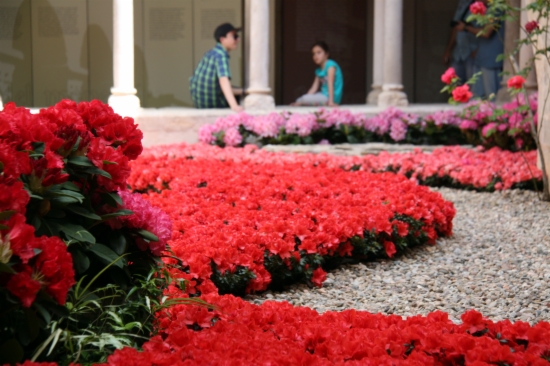Girona turns into Catalan Capital of spring as 60th edition of 'Temps de Flors' flower festival kicks off
The 60th edition of the 'Girona, Temps de Flors' flower festival kicked off on Saturday and will run until the 17th of May. For the event, around 1,000 students, volunteers, designers and florists have come together, working on 164 flower installations, distributed over 134 spaces all around the city. The festival is expected to attract more than 200,000 visitors, providing the city with a true international dimension. Two official itineraries have been set up, allowing tourists to walk around discovering many of Girona's magical corners. According to event organisers, the top 10 sites not to be missed are: the Funeral Chapel of Sant Nicolau, the Basilica of Sant Feliu, Jurats Square, the Arab Baths, the Girona's iconic Cathedral, the Church of Sant Lluc, the building of Sarraïnes, Rabbin House Lleó Avinay, Els Alemanys Gardens and the Church of Sant Martí. This year, the Festival's budget amounted to €400,000.

Girona (ACN).- The 60th edition of the 'Girona, Temps de Flors' flower festival kicked off on Saturday and will run until the 17th of May. For the event, around 1,000 students, volunteers, designers and florists have come together, working on 164 flower installations, distributed over 134 spaces all around the city. The Festival is expected to attract more than 200.000 visitors, providing the city with a true international dimension. Two official itineraries have been set up, allowing tourists to walk around discovering many of Girona's magical corners. According to event organisers, the top 10 sites not to be missed are: the Funeral Chapel of Sant Nicolau, the Basilica of Sant Feliu, Jurats Square (the Courts of Justice Square), the Arab Baths, the Girona's iconic Cathedral, the Church of Sant Lluc, the building of Sarraïnes, Rabbin House Lleó Avinay, Els Alemanys Gardens (the German Gardens) and the Church of Sant Martí. This year, the Festival's budget amounted to €400,000.
Girona's streets are unusually packed with people these days. Young and old, foreign and Catalan, first-time visitors and ‘aficionados’, are all getting together to attend one of the most exciting events of the year: the 60th edition of Girona's Flower Festival. Strolling around the historical streets of the city or sipping a beer in one of its buzzing cafes, an attentive listener will soon notice the truly international character of the event. Indeed, the Catalan, Spanish and French languages intermingle continuously, giving the impression that, at least for some days, this small city has become a capital in miniature. "Girona is the capital of the Catalan spring", stated Catalan actor Quim Masferrer, at the opening ceremony of the event.
164 different flower displays in 134 different locations throughout the city
As the 'Temps de Flors' festival offers 164 flower installations in a total of 134 spots, in order to know your way around it is useful to get a copy of the festival programme from the tourist offices. There, 2 official itineraries are displayed that will guide you through some amazing flower installations, also representing a not-to-be-missed opportunity to discover Girona's patios, gardens and monuments. Moreover, lovers of technology could enjoy downloading on their smartphones the audio guide, available for the floral projects located in the 10 most prominent spots of the city, such as the Arab Baths, the Chapel of Sant Nicolau and the Basilica of Sant Feliu.
According to visitors, among the numerous flower installations, the giant floating flowers on the Onyar River (which runs through the city centre) and the green carpet in Girona's Cathedral were two of this year’s favourite productions.
Strengthening ties with Ghent
Flowers have become an opportunity to enlarge the Catalan city's 'diplomatic' relations as well. Indeed, this year Girona concluded an agreement with the Belgian city of Ghent, where another important flower festival called Floraliën is held every 4 years. Ghent participates in the 60th edition of 'Temps de Flors' with an installation consisting of 1,000 Ghent azaleas, 60 balloons woven grasses, 1,500 roses, 1,500 gerberas and 30 white azaleas. Realised for a total of €10,900, the installation is located in the St. Daniel Monastery, a monument that in previous years was excluded from the itineraries. In turn, the city will be invited to the renowned Belgian contest in 2016. The Catalan city's Mayor, Carles Puigdemont, has already announced that "it is only the beginning of a closer cooperation that will involve all kinds of projects".
Using recycled materials as well
However, flowers are not the only protagonists of this year's installations. Other decorative elements have been creatively recycled and used as well, such as hand-painted bicycles, old wooden frames, colourful vegetables and different types of furniture. Furthermore, some amazing parallel shows are scheduled throughout the week in order to entertain visitors wandering around the city. On Sunday, for example, in front of the Basilica of Sant Feliu, three different teams of 'castellers' (Marrecs de Salt, Xics de Granollers, and Sagals d'Osona) drew bystanders' attention building and dismantling some impressive human towers, according to a Catalan tradition recognised as a Heritage of Humanity by UNESCO since 2010.
During the 9-day event, many restaurants offer menus inspired by the leading theme of the Festival and night life lovers can also enjoy cocktails, appetisers or sweets made with flowers. So far, locals have noticed an increase in the numbers of visitors in comparison with previous years. "It's very nice but I recommend everyone to come and visit during the week as it is much quieter," explained John Fajula, a resident from the nearby town of Cassà de la Selva.